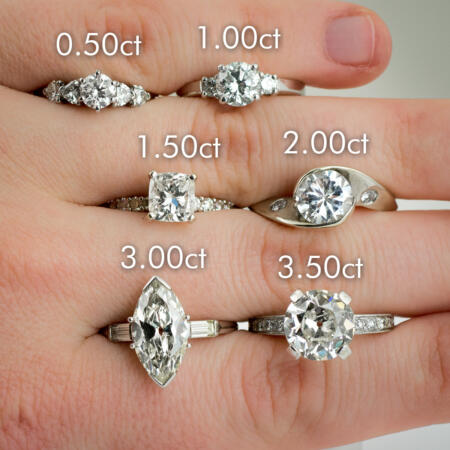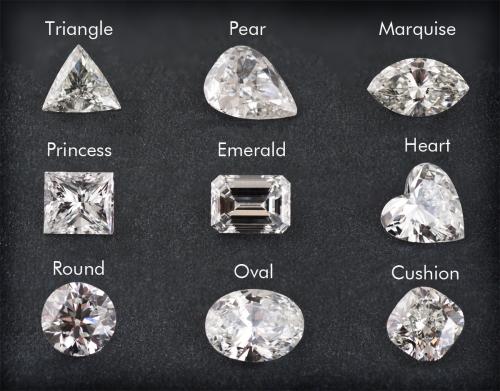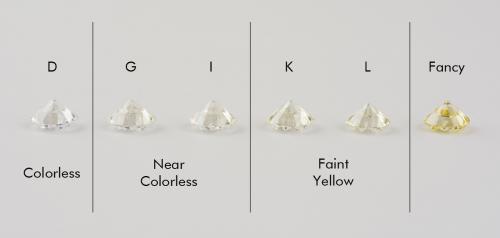Diamond Buying Guide: The 4 C’s
Learn About Diamond Color, Cut, Clarity, and Carat Weight
If you understand how diamonds are graded, you have a better chance of finding the right one for you. At Arden Jewelers, our gemologists are more than happy to answer any questions you have so please feel free to visit us anytime.
Carat Weight
Diamonds are small, so the scale that is used to describe diamond weights uses very small units. A carat equals 1/5 of one gram. A carat is divided into 100 points. A diamond can be described as 75 points or 0.75 carats or 3/4 of a carat. It is a good practice to know the exact weight of a diamond when buying or selling.
The weight of a diamond is often thought of in terms of its size. If you know that you like the look of a 1 carat, for example, you can use this C as the starting point for your diamond search. Once you know the carat weight and your budget, you can adjust the quality of the diamond to fit. Unless you work in the jewelry trade, it can be hard to know what size you want. The photo above shows some common diamond carat weights and how they look in comparison to each other.
Cut
The Cut of a diamond has two main components. First, cut refers to the shape of the stone. Round, marquise, pear, oval, square, princess all describe the shape of the diamond. Checkout the picture above to see examples of the most popular diamond shapes. There are many more shapes than we can list here and there are even variations on the common shapes with more facets or different facet patterns.
When you are choosing a diamond shape, keep in mind that different shapes have different light properties. Some shapes, like round, are especially good at returning light to the viewer which makes them sparkle more than other shapes. The emerald cut, for example, gives a classic look with big flashes of light but very little sparkle or fire. Ultimately, it’s up to you to pick the shape that you like best.
The second component to diamond cut is the way the facets are positioned on the diamond. When a diamond is cut to quality proportions (regardless of its shape) the maximum light is returned through the top of the stone giving a great light show. Cuts that are too shallow or too deep allow light to escape resulting in loss of brilliance.
Color
Judging diamond color is actually looking for the absence of color or transparency (except fancy color). The color grading scale starts with D meaning totally colorless and moves down the alphabet subtly increasing in body color. As you can see from the picture, the difference between one or two color grades is quite small, but the price difference can be significant.
When deciding on a color for your diamond, you may choose to go down a color grade to allow you to buy a larger diamond for the same price. Or, you may want to get the whitest diamond possible to outshine your friends when you put them side-by-side. It’s all about discovering what’s most important to you. Also, keep in mind that the color of the metal you set your diamond in will have a big impact on how it appears. If a diamond is in the colorless range (D-F), and it’s set in yellow gold, it may appear to be much more yellow than it is.
Fancy color diamonds are a fun, non-traditional option. While natural fancies can be very rare and extremely expensive, we now have the technology to permanently color a white diamond to almost any color you can imagine. You can read more about fancy diamond colors here.
Clarity
Most diamonds contain inclusions. Inclusions are natural birthmarks and useful as identifying characteristics. Clarity grading is done with 10 power magnification. The number, size, type, and location of inclusions determine the grade. The fewer inclusions, the more valuable the diamond.
| Grade | Name | Explanation |
|---|---|---|
| FL | Flawless | No blemishes or inclusions |
| IF | Internally Flawless | No inclusions, only insignificant blemishes |
| VVS1-VVS2 | Very, very slightly included | Minute inclusions difficult to see |
| VS1-VS2 | Very slightly included | Minor inclusions difficult to somewhat easy to see |
| SI1-SI2 | Slightly included | Noticeable inclusions that are easy to see |
| I1-I2-I3 | Eye visible inclusions | Obvious inclusions, I3 may threaten durability |


